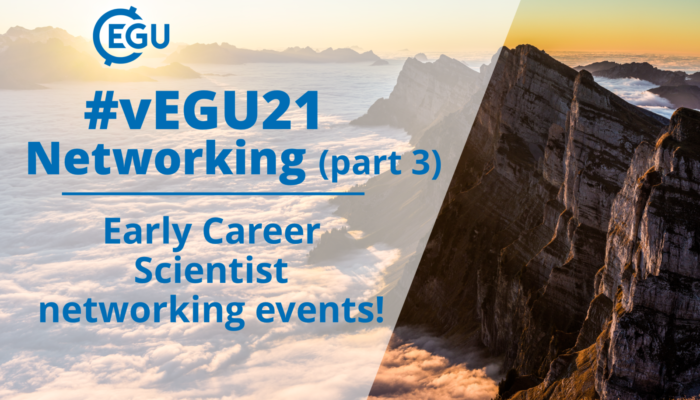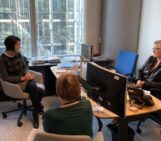
From Monday to Friday over the two weeks of #vEGU21 the Early Career Scientists will be hosting networking events specific to each of the EGU’s Divisions. Keep up-to-date and discover when each ECS Division networking event is, alongside other details, in the EGU Programme by selecting “Please Select” and then “Networking” in the session programme page. Keep an eye out for other ECS events too, like the ECS Union-wide Networking event and the ECS Forum.
If you’re unsure as to which Division your research falls under, then check out the descriptions below alongside the date and time of their event. All the Divisions hosting ECS Networking events are listed here in date-order for their respective Networking event. You might find that your research fits under more than one Division, in which case feel free to attend multiple networking sessions! If you want to organise your own networking session then check out the conference Pop-Up Scheduler.
Monday 19 April 2021 12.30 CEST: Geodesy [G]
Traditionally geodesy is the science of the measurement and the mapping of the Earth’s surface. Since the surface is mainly shaped by the Earth’s gravity field the classical definition includes the Earth’s gravitational potential. Observing the Earth figure, the orientation and rotation as well as the gravity field, geodesy today provides spatial and temporal patterns of geophysical processes within the Earth system such as sea level rise, tides, melting of continental ice masses, changes in global water circulation and in the atmosphere or deformations of the solid Earth. Consequently, the geodesy Division covers activities on the whole spectrum of modern geodetic Earth system modeling from the measurement systems to the investigation of geophysical processes.
Tuesday 20 April 2021 12.30 CEST: Geodynamics [GD]
Studies related to the Geodynamics Division include all aspects of geodynamic processes in the lithosphere, mantle, and core. Geodynamicists use different approaches (e.g., analytical, numerical, and analogue modelling) to study dynamic processes on a large variety of time- and length-scales. These processes include, but are not limited to, the dynamics of subduction, mid-ocean-ridge processes, plate movements driving mountain building and basin formation, lithosphere dynamics, mantle convection, and core dynamics. Geodynamics is therefore a highly interdisciplinary field and plays a crucial role in integrating different disciplines in the Geosciences, such as geochemistry (GMPV), mineral physics (EMPV), geology (TS), geomorphology (GM), seismology (SM), and planetary sciences (PS). Everyone feeling any type of affiliation with Geodynamics is therefore very welcome to join the GD ECS event!
More details on their networking event can be found here.
Tuesday 20 April 2021 12.30 CEST: Ocean Sciences [OS] & Stratigraphy, Sedimentology, Palaeontology [SSP]
OS: The Ocean Sciences Division of the European Geosciences Union (EGU) has the major objective to provide an attractive and productive environment for scientists from Europe and all over the world to gain progress in the various ocean science disciplines and have beneficial interactions with other fields of Geosciences. For that purpose, we organise with the teams of conveners the ocean science part of the program of the scientific conference that his held every year during the EGU General Assembly. We give special attention to topics cross-cutting with those of other Divisions. We recognise deserving colleagues in various stages of their careers with our Award program: the Division awards the Fritdjof Nansen Medal to mid or full career scientists and the Outstanding Young Scientists Award for younger scientists. We also award prices to outstanding student posters at every general assembly. The Division maintains very strong links with the EGU publication committee, and especially with the board of Editors of the open access journal Ocean Science (OS). The Division also contributes with the EGU Education and Outreach committee to the organisation of relevant topical conferences and summer schools.
SSP: The Stratigraphy, Sedimentology and Palaeontology Division (SSP) focuses its activities on all aspects of the sedimentary record. About 70 % of the Earth surface is covered by sedimentary deposits, which are eroded and deposited right at the contact between the solid lithosphere and the atmosphere, biosphere and hydrosphere. Sedimentary rocks record the history of our planet since almost 4 billion of years and play a pivotal role for our understanding of the evolution of life. This deep-time archive of Earth history is studied with a wide range of analytical techniques providing ever stunning details on the evolution of our planet. Sedimentary basins host important natural resources like coal, gas, oil, ore deposits and groundwater and therefore a better understanding of the physical, chemical and biological processes controlling the formation and distribution of sediments and sedimentary rocks is of utmost importance for our society.
Wednesday 21 April 2021 12:30 CEST: Natural Hazards [NH]
“The Natural Hazards (NH) Division of the EGU covers all the geological and geophysical processes that can be hazardous and can produce damage to the environment and to the society.” These words are the opening of the NH Division homepage and capture very well the multidisciplinary essence of our Division. From Volcano to Earthquake, from Hydro-Meteorological to Landslide, from Wildfire to Sea & Ocean hazards passing through Biological and Environmental Hazards. The hazards relation to Remote Sensing and Society, and concluding with Multihazards, this Division brings together many diverse disciplines. Within it, a group of ECS aims a fostering network, multidisciplinary collaboration and science communication.
Wednesday 21 April 2021 12:30 CEST: Cryospheric Sciences [CR]
The Cryosphere are those parts of the Earth and other planetary bodies that are subject to prolonged periods of temperatures below the freezing point of water. These include glaciers, frozen ground, sea ice, snow and ice. One of the main aims of the EGU Division on Cryospheric Sciences is to facilitate the exchange of information within the science community. It does so by organizing series of sessions at the annual EGU assembly, and through the publishing of the open-access journal `The Cryosphere’. The Division awards the Julia and Johannes Weertman medal for outstanding contributions to the science of the cryosphere. The ‘cryo blog’ is a weekly blog post by members of the cryosphere community. The blogs cover all aspects of the cryosphere, as well as covering topics important to ECS such as mental health and career development.
Wednesday 21 April 2021 18.00 CEST: Atmospheric Science [AS]
Atmospheric Sciences Division is one of the largest Divisions in the European Geosciences Union. The research areas covered by Division extend from the large-scale dynamical/meteorological processes and systems in the atmosphere (like cyclones and global atmosphere circulation) to the small scale turbulent mixing, they cover the time frame from centuries (in connection with climate research) to seconds (in the context of fast chemistry). Atmospheric Sciences include studies of the atmosphere composition, aerosol and cloud physics, gas-particles interactions and chemical reaction kinetics studied in the labs.
More details on their networking event can be found here.
Thursday 22 April 2021 18.00 CEST: Geochemistry, Mineralogy, Petrology and Volcanology [GMPV]
The Geochemistry-Mineralogy-Petrology-Volcanology Division includes disciplines that are fundamental to, but not restricted to studies of the solid earth. Important themes include the nature, composition, structure of the Earth’s mantle; the composition, origin and evolution of the oceanic and continental crust; the formation and crystallization of magmas; the chemical compositions of igneous, metamorphic and sedimentary rocks; element transfer between the surface envelopes of the earth; chemical and physical properties of minerals; volcanoes and volcanism. While most of these studies fall in the realm of fundamental research, studies of pollution in the surface or subsurface waters, the formation of ore deposits, and the environmental impact of volcanism are examples of more applied research.
Tuesday 20 April 2020 19.00 CEST: Tectonics and Structural Geology [TS]
The Division on Tectonics and Structural Geology (TS) stands at the cross-roads among several Earth Sciences disciplines (geophysics, geochemistry, petrology and mineralogy, geomorphology, natural hazards, and volcanology). We investigate the structure, deformation, dynamics and evolution of the Earth’s lithosphere at all spatial and temporal scales. During this across-scales analysis to decipher the complex relationships that define the dynamics of the Earth System, we use the governing laws of physics and chemistry alongside observations derived from the field, mapping, remote sensing and seismics, as well as experimental and numerical methods. Given its highly interdisciplinary nature, the Division has strong ties with other EGU Divisions including GD, EMRP, SM, SSP, GM, G, and GMPV.
Thursday 22 April 2021 18.00 CEST: Climate: Past, Present, & Future [CL]
The Division on Climate: Past, Present & Future is one of the larger Divisions of the European Geosciences Union. It pools from many disciplines and consequently has many co-organized and co-listed sessions with other Divisions at the general assembly. The Division is very interdisciplinary and covers climate variations on all time scales. CL includes the study of any kind of climate archive from rocks to ocean cores, speleothems, ice cores, chronicles, to instrumental records to name a few. Besides observations, climate modeling on all time scales from the deep past to the future are areas covered by the Division. Any aspect of the climate system falls into the realm of the Division e.g. atmosphere, ocean, biosphere, cryosphere, and geology. Themes focus on the climate on Earth but may also expand other planets or the sun.
More details on their networking event can be found here.
Thursday 22 April 2021 18.00 CEST: Nonlinear Processes in Geosciences [NP]
Although the geosciences are rife with nonlinearity, the NP Division is focused on a series of nonlinear paradigms whose applications cut across the “geospheres” disciplines. We can mention a wide range of fields as deterministic chaos, tipping points, nonlinear waves, similarity across scales (scaling, scale invariance, fractals, multifractals), network theory, stochasticity, predictability and its limits, pattern formation, self-organized criticality, extreme events. Thus, the NP Division is highly inter-/multidisciplinary, playing a crucial role in fundamental geoscience, whose applications include new methodologies, new modelling, new paradigms, new data analysis techniques, and new modeling procedures.
Monday 26 April 2021 12:30 CEST: Hydrological Sciences [HS] & Geosciences Instrumentation and Data Systems [GI]
HS: The hydrological sciences have their own Division within the European Geosciences Union. The Hydrological Sciences Divisions is concerned with all aspects of the terrestrial hydrological cycle (including precipitation, surface water, soil water, groundwater) from the pore scale to the global scale, and its relationships and interactions with the atmospheric part of the hydrological cycle. The Division also covers the interaction between hydrology and geomorphology (e.g., erosion, sedimentation, groundwater systems), the relationships between hydrology and soils, as well as the interaction between the hydrosphere and the biosphere (e.g., ecohydrology, wetlands). Furthermore, the ways in which hydrological processes are observed, quantitatively computed, and forecasted are addressed by the Division. Management and operation of water resources by societies in various parts of the world is also within the Division’s realm.
GI: Opposed to other Divisions concentrating on specific fields of geosciences, this Division intends to be a forum for developments in instrumentation, technology, methods and data handling used in any field of the various geosciences. By promoting the discussion between specialists from widely diverse fields, advances in instrumentation made in one field might be utilized in other areas also and encourage co-operation, thereby saving separate development work and making new approaches possible, which otherwise might still have to wait for years or even decades. As nearly every other field of geosciences is related to one or the other instrumentation strategy, many of the GI-sessions are co-organized with sessions from other Divisions. Potential contributors to any session are encouraged to evaluate the benefits of a multi-disciplinary discussion versus the specific interest of the own target group.
Tuesday 27 April 2021 12:00: Earth and Space Science Informatics [ESSI]
As far as informatics and information technology are concerned, the ESSI Division deals with community-driven and multidisciplinary challenges and solutions. This includes topics like: spatio-temporal data modelling and meta-data standardisation, spatial data infrastructure interoperability, semantics services, quality and uncertainty information encoding and propagation, geospatial data processing, environmental model accessibility, big data management, and data visualisation for scientific discovery.
Tuesday 27 April 2021 18.00 CEST: Earth Magnetism and Rock Physics [EMRP]
The Earth is a dynamic planet: its interiors’ electro-magnetism and physical properties contribute to this exciting property of our planet. The Earth Magnetism & Rock Physics (EMRP) Division addresses the experimental, theoretical and modelling approaches of fundamental solid-Earth and magneto-hydrodynamic processes that extend from the Earth’s surface to the core. A continuous demand for a better understanding of the magneto-hydrodynamic and physical processes responsible for the Earth’s magnetic field spatial and temporal variability is required. Theoretical and experimental aspects of rock physics, environmental magnetism, magnetic anomalies and plate tectonic reconstructions, magnetic polarity reversals, petrophysical assessment throughout physical, mechanical and magnetic properties, electrical conductivity and transport properties of the Earth’s crust and mantle are some of the key topics of research of our ‘living planet’ to which this Division is dedicated.
Tuesday 27 April 2021 18.00 CEST: Energy, Resources and the Environment [ERE]
The European Geosciences Union (EGU) brings together geoscientists from all over Europe and the rest of the world, covering all disciplines of the earth, planetary and space sciences. This geoscientific interdisciplinarity is needed to tackle the challenges of the future. A major challenge for humankind is to provide adequate and reliable supplies of affordable energy and other resources. These should be obtained in environmentally sustainable ways, which is essential for economic prosperity, environmental quality and political stability around the world. One goal of the Division Energy, Resources & the Environment (ERE) is to be a leading discussion forum for these issues. The core of the Division consists of experts in various fields that will help meet the mutually coupled challenges of Energy, Resources and the Environment.
Wednesday 28 April 2021 18.00 CEST: Geomorphology [GM]
[POP-UP EVENT]
Geomorphology is the scientific study of land-surface features and the dynamic processes that shape them. The Division brings together research on processes that build topography through e.g. the effects of tectonic forces as well as processes that modify the terrain such as weathering and erosion under the action of surface runoff, waves, glacial ice, wind, biota and gravitational forces. Division members also study the impact of humans on geomorphological processes and investigate how geomorphological knowledge can be applied to solve problems of relevance to societies, such as geohazards.
Wednesday 28 April 2021 19.00 CEST: Seismology [SM]
Seismology as a discipline contributes to a large variety of both basic and applied scientific fields, and addresses important topics in the context of both natural resources and natural hazards. The seismology (SM) Division at EGU aims to strengthen its inter-disciplinarity and impact by driving the development from static to dynamic geophysical models, by conducting research that spans from acquisition parameters to petrophysical properties, and by supporting the transition from geo-modeling to geo-technical application. Thereby, the SM Division will be increasingly able to make relevant forecasts and provide valuable information to tackle future challenges in securing natural resources and quantifying natural hazards.
If you want to discuss these seismological and non-seismological topics, join us for a digital beer in our virtual Bermuda Bräu! We will not only provide a source for scientific discussions, but also provide you with fun, singing, games and dinosaurs! Join us.
Wednesday 28 April 2021 19.00 CEST: Bio-geosciences [BG]
The Division of Biogeosciences integrates biological, chemical, and physical sciences dealing with processes and interactions within terrestrial and extraterrestrial realms through the current and earlier geological history of Earth and solar system in general. Its focus is beyond the established scientific approaches embracing multi- and interdisciplinary understandings of the biosphere functioning in space and time. In this Division, we encourage the participation of scientists across different disciplines, including researchers from the field of applied biogeosciences as well as industrial professionals. Experimental, conceptual, and modelling approaches are welcome.
Thursday 29 April 2021 18.00 CEST: Soil System Sciences [SSS]
Soil is the interface between the crust and atmosphere, and is the basis of life on earth. The impact of Soil Science to the society has probably never been as high as it is currently. The importance of soils in the Earth System must make us, the soil scientists, more noticeable at the EGU.The aim of the SSS is to coordinate the EGU scientific programme on Soil Science and related activities. The SSS contributes actively with EGU by promoting scientific interchange and dissemination of activity carried out by members.
Thursday 29 April 2021 18.00 CEST: Planetary and Solar System Sciences [PS]
The aim of the Planetary & Solar System Sciences (PS) Division is the promotion of all fields of planetary sciences, ground-based and space mission exploration of the solar system and beyond, and related models. PS covers papers on both fundamental and applied topics regarding the exploration of the solar system. The Division, devoted to science applications in space, hosts interdisciplinary contributions on the origins and the evolution of the solar system and the exoplanetary systems, as well as ideas for future exploration while largely contributing to outreach and educational activities for all audiences.
For more information about Early Career Scientist activities at EGU please email: networking@egu.eu. For help with the vEGU21 platform or the Virtual Conference Centre, please email: egu21@copernicus.org.




